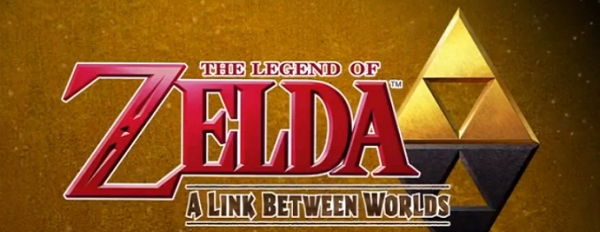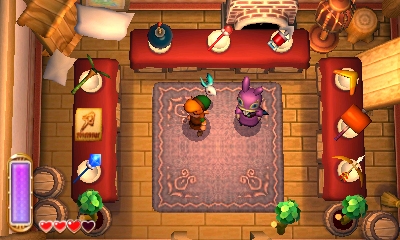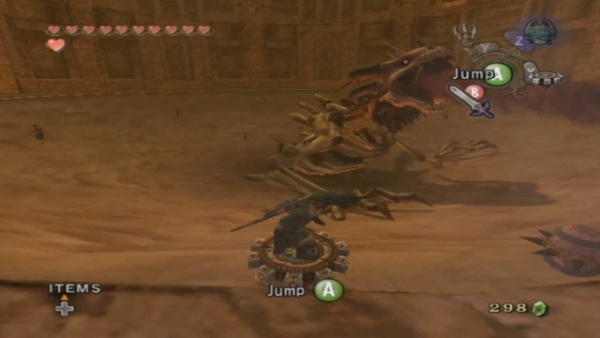
According to the most recent Nintendo Direct presentation, The Legend of Zelda: A Link Between Worlds will, in the words of Nintendo President Satoru Iwata, “transform the way you play Zelda.” After years of following a consistent, popular formula, Nintendo has finally seen the need for progression. The next Zelda game will “buck the mold” of traditional Zelda gameplay with one revolutionary change: items will now be rented from and bought at a shop, rather than found in a dungeon.
 Here we see Ravio’s item shop, featuring many of Link’s most popular items, including the hookshot, boomerang, and bow. This, ladies and gentlemen, will revolutionize The Legend of Zelda franchise: buying your items from a weird… purple… rabbit-man thing. The realistic idea behind the change is that it will allow players to progress through the world in a more open-ended fashion, rather than the strict linear gameplay that previous Zelda titles have followed. Until now, the method has been “enter this dungeon, find this item, use this item to beat the dungeon, and then never really use the item again.” True, certain items have had a large enough impact to be featured in many dungeons, such as the bow. Some items are even popular enough to have two dungeons (I’m looking at you, Double Clawshot from Twilight Princess). Unfortunately, many items that were really cool concepts faded into relative obscurity after their dungeon. One of the greatest boss fights in Zelda history was the Twilit Fossil Stallord, and this was largely because of the mechanics to fight him. Using the Spinner to climb the walls and reach Stallord’s skull was one of the most epic, cinematic experiences of any Zelda bossfight, and after the battle, the Spinner was rarely, if ever, used again.
Here we see Ravio’s item shop, featuring many of Link’s most popular items, including the hookshot, boomerang, and bow. This, ladies and gentlemen, will revolutionize The Legend of Zelda franchise: buying your items from a weird… purple… rabbit-man thing. The realistic idea behind the change is that it will allow players to progress through the world in a more open-ended fashion, rather than the strict linear gameplay that previous Zelda titles have followed. Until now, the method has been “enter this dungeon, find this item, use this item to beat the dungeon, and then never really use the item again.” True, certain items have had a large enough impact to be featured in many dungeons, such as the bow. Some items are even popular enough to have two dungeons (I’m looking at you, Double Clawshot from Twilight Princess). Unfortunately, many items that were really cool concepts faded into relative obscurity after their dungeon. One of the greatest boss fights in Zelda history was the Twilit Fossil Stallord, and this was largely because of the mechanics to fight him. Using the Spinner to climb the walls and reach Stallord’s skull was one of the most epic, cinematic experiences of any Zelda bossfight, and after the battle, the Spinner was rarely, if ever, used again.

Unfortunately, I don’t think that this new item shop will solve the problem, nor will it change things overmuch from a gameplay standpoint. In all likelihood, a pattern will emerge for the game where a certain order is simply smarter or easier than others, much like in Mega Man X, for example. Another problem is that this will likely make the story less coherent or watered-down. While the dungeons are usually plot points that further the narrative in a meaningful way, allowing players to do them in a random order will make them simply plot “checkpoints,” where the dungeon is part of its own segment of the story, rather than a part of the story as a whole.
Take Dragon Age: Origins, for example. When playing the game, you are allowed to visit one of four locations at a time and finish your quests there. The goal is to recruit an army to end the blight, but each area has its own problems that must be solved: Demons in the Mage Tower, Undead in Redcliffe, slavery in Denerim, and Werewolves in the Forest. As a result, each area becomes about its own self-contained story and is only loosely tied to the over-arcing narrative regarding the archdemon. You get sort of a “thanks for your help. We’ll be there when the Darkspawn attack” at the end of it, as if to say “hey, now that you’ve finished this story, allow me to remind you what the actual plot is!” Such an approach to Zelda may end up detracting from Link’s quest to vanquish Ganon.
Of course, the ultimate irony is that a shop where you can buy items is nothing new to the Legend of Zelda franchise. There were secret shops hidden throughout the very first Zelda game for the NES, and many people remember the infamous shopkeeper from Link’s Awakening, who would kill players on sight if they stole from him. While none of these shops sold core dungeon items like the Gust Bellow or the Ball and Chain, it’s still worth noting that this isn’t a feature that is completely new to the series. Let’s face it, Zelda games aren’t exactly known for their ingenuity. While they were revolutionary back in the day, recent installments have been a bit stale when it comes to innovative additions. You’re talking about a franchise that is so in love with its own history that it consistently re-releases old titles. Ocarina of Time has been released five times: twice on the Gamecube, once for the Virtual Console, and now for the 3DS. The amazing part is that even now, over a decade later, Ocarina of Time 3D sold 2.95 million copies, more than Kid Icarus: Uprising and Super Street Fighter IV: 3D Edition combined.
People have loved Zelda games for decades; however, the most significant evolution of the franchise hasn’t been in gameplay, but in story. Ocarina of Time was notable for its use of Z-targeting, but the combat at its core was still hack-n-slash. The game’s most auspicious trait was its compelling story. Link went from being an outcast child to the battle-hardened, teenage Hero of Time. Zelda grew from a meek princess to a resolute ruler. Characters had more depth than ever before. Ocarina of Time’s story was so epic in its scope that it turned out to be the keystone upon which the entire franchise’s continuity leans. One of the greatest strengths of the story was in the linear fashion in which the temples were presented. Perhaps I’m reading too much into it, and the item shop in A Link Between Worlds won’t actually change the overall method of playing Zelda games at all, but even if that does end up being the case, is it then fair for Iwata to claim that this will “transform the way you play Zelda?” Especially when the producer of the game drew parallels to Majora’s Mask.
I don’t think anyone would be against a bit of change in the Legend of Zelda franchise, but Nintendo needs to focus on making changes in a meaningful way. In order to truly transform the way gamers play Zelda, Nintendo’s focus should be on utilizing next generation hardware to accomplish things that weren’t possible in the past, like bringing more life to the characters or environments. Instead, it just seems that they’re slapping a new coat of paint on an old concept and trying to pass it off as innovation.






